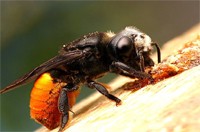Unlike honey bees or wasps, resin bees are not aggressive. Since they don’t form colonies, they have no hive to defend, which means they’re much less likely to exhibit defensive behaviour. Stinging is typically a last resort, used only when the bee feels physically threatened, such as being squeezed, trapped, or handled roughly.
Even in the rare event of a sting, resin bee venom is mild. For most people, the sting may cause only minor irritation. Of course, those with bee sting allergies should remain cautious around any bee species, including native ones.
Why Are Resin Bees Nesting Around My Home?
Resin bees are always searching for small, sheltered spaces to nest. Unfortunately, many homes provide the perfect environment—small holes in wooden beams, unsealed brickwork, and gaps in external walls are all attractive to these bees.
Though they don’t bore into wood like carpenter bees, resin bees can still end up nesting in vulnerable parts of a property. Gaps in cladding, old fencing, and even unused piping can become a convenient entry point for them.
They rarely cause damage themselves, but their presence in high-traffic areas—especially around doors, balconies, or children’s play zones—can cause concern.
Are Resin Bees Dangerous?
Generally, no. Resin bees are beneficial insects that play an important role in pollination. Their presence helps keep gardens healthy and supports native plant species. They’re non-aggressive and more interested in collecting resin and pollen than interacting with people.
However, there are times when their presence becomes problematic:
- Nests are located close to doors, windows, or entryways
- There’s a growing number of bees in one area
- A household member is allergic to bee stings
In such cases, removal or relocation might be necessary—not because resin bees are dangerous, but to ensure peace of mind and safety.
When to Consider Bee Control Services Melbourne
Not every bee issue needs removal, but if the bees are nesting close to living spaces or in difficult-to-reach locations, professional assistance may be the safest option.
Bees removal in Melbourne offers gentle, eco-conscious solutions designed to manage bee activity without harming the bees themselves. With a focus on safety and sustainability, services include identification, assessment, safe removal, and prevention.
Every situation is different. Sometimes, resin bees can be left undisturbed. Other times, they may need to be relocated or deterred using non-toxic, environmentally friendly methods.
What to Expect During Professional Beehive Removal Melbourne
Though resin bees don’t create large, traditional hives, they can form clustered nesting sites in walls, fences, or timber. If the nest needs to be removed, professionals follow a careful, multi-step process to ensure safety for both humans and bees.
- Site Inspection: A thorough inspection helps determine the bee species, nest location, and whether removal is necessary.
- Tailored Plan: The best method of removal or relocation is chosen based on the bees’ location, structure of the nest site, and risk level.
- Safe Extraction or Relocation: Using specialised tools and techniques, the bees are gently removed and relocated to a more suitable habitat.
- Prevention and Advice: After the removal, entry points are sealed, and practical tips are provided to discourage future nesting.
This approach ensures long-term protection for your property while safeguarding one of Australia’s most important native pollinators.
Why DIY Isn’t Always the Best Option
It might be tempting to try and deal with resin bees using sprays, plug holes with filler, or block them off—but DIY attempts often backfire. Blocking a nest can trap live bees inside, resulting in dead bees and decaying material that attracts other pests.
Chemical sprays are not only harmful to bees, but also to people, pets, and the surrounding environment. Resin bees are non-aggressive and don’t need to be destroyed—just managed with care.
Professionals have the tools, knowledge, and protective equipment to handle the situation safely, without risk to you or your home.
Preventing Resin Bees Around Your Home
If you’d prefer not to have resin bees nesting too close to your living spaces, a few preventative measures can go a long way:
- Seal gaps and cracks in brickwork, timber, and external walls
- Repair damaged fences or wooden panels
- Cover weep holes, vents, or pipe gaps with breathable mesh
- Use natural, bee-safe deterrents in known nesting spots
These small actions won’t harm bees but will help steer them toward more natural nesting environments—like bush land or native gardens—where they’re less likely to interfere with human activity.
Australia’s native bees, including resin bees, are essential for plant diversity and food production. While they may sometimes nest in inconvenient places, removing or relocating them responsibly helps preserve their population.
Through services like beehive removal in Melbourne, it’s possible to strike a balance between safety and conservation. With the right approach, everyone wins—you, your property, and the bees.
If you’ve noticed increased resin bee activity around your home and aren’t sure whether it’s a problem—or how to deal with it—it might be time for a professional opinion. Call Bees removal Melbourne on 03 9021 3752 for a free quote or expert advice. whether it’s a one-off visit or an ongoing issue, friendly support is just a phone call away. The aim isn’t to harm bees—but to manage them in a way that’s safe for your home and kind to the environment.




